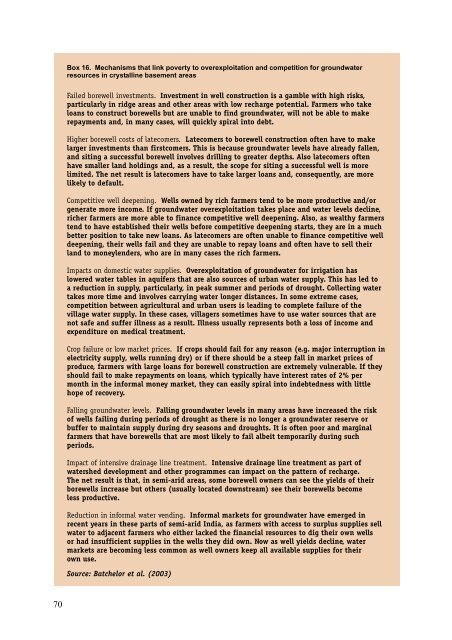5. Access to water resources - Natural Resources Institute
5. Access to water resources - Natural Resources Institute
5. Access to water resources - Natural Resources Institute
Create successful ePaper yourself
Turn your PDF publications into a flip-book with our unique Google optimized e-Paper software.
Box 16. Mechanisms that link poverty <strong>to</strong> overexploitation and competition for ground<strong>water</strong><strong>resources</strong> in crystalline basement areasFailed borewell investments. Investment in well construction is a gamble with high risks,particularly in ridge areas and other areas with low recharge potential. Farmers who takeloans <strong>to</strong> construct borewells but are unable <strong>to</strong> find ground<strong>water</strong>, will not be able <strong>to</strong> makerepayments and, in many cases, will quickly spiral in<strong>to</strong> debt.Higher borewell costs of latecomers. Latecomers <strong>to</strong> borewell construction often have <strong>to</strong> makelarger investments than firstcomers. This is because ground<strong>water</strong> levels have already fallen,and siting a successful borewell involves drilling <strong>to</strong> greater depths. Also latecomers oftenhave smaller land holdings and, as a result, the scope for siting a successful well is morelimited. The net result is latecomers have <strong>to</strong> take larger loans and, consequently, are morelikely <strong>to</strong> default.Competitive well deepening. Wells owned by rich farmers tend <strong>to</strong> be more productive and/orgenerate more income. If ground<strong>water</strong> overexploitation takes place and <strong>water</strong> levels decline,richer farmers are more able <strong>to</strong> finance competitive well deepening. Also, as wealthy farmerstend <strong>to</strong> have established their wells before competitive deepening starts, they are in a muchbetter position <strong>to</strong> take new loans. As latecomers are often unable <strong>to</strong> finance competitive welldeepening, their wells fail and they are unable <strong>to</strong> repay loans and often have <strong>to</strong> sell theirland <strong>to</strong> moneylenders, who are in many cases the rich farmers.Impacts on domestic <strong>water</strong> supplies. Overexploitation of ground<strong>water</strong> for irrigation haslowered <strong>water</strong> tables in aquifers that are also sources of urban <strong>water</strong> supply. This has led <strong>to</strong>a reduction in supply, particularly, in peak summer and periods of drought. Collecting <strong>water</strong>takes more time and involves carrying <strong>water</strong> longer distances. In some extreme cases,competition between agricultural and urban users is leading <strong>to</strong> complete failure of thevillage <strong>water</strong> supply. In these cases, villagers sometimes have <strong>to</strong> use <strong>water</strong> sources that arenot safe and suffer illness as a result. Illness usually represents both a loss of income andexpenditure on medical treatment.Crop failure or low market prices. If crops should fail for any reason (e.g. major interruption inelectricity supply, wells running dry) or if there should be a steep fall in market prices ofproduce, farmers with large loans for borewell construction are extremely vulnerable. If theyshould fail <strong>to</strong> make repayments on loans, which typically have interest rates of 2% permonth in the informal money market, they can easily spiral in<strong>to</strong> indebtedness with littlehope of recovery.Falling ground<strong>water</strong> levels. Falling ground<strong>water</strong> levels in many areas have increased the riskof wells failing during periods of drought as there is no longer a ground<strong>water</strong> reserve orbuffer <strong>to</strong> maintain supply during dry seasons and droughts. It is often poor and marginalfarmers that have borewells that are most likely <strong>to</strong> fail albeit temporarily during suchperiods.Impact of intensive drainage line treatment. Intensive drainage line treatment as part of<strong>water</strong>shed development and other programmes can impact on the pattern of recharge.The net result is that, in semi-arid areas, some borewell owners can see the yields of theirborewells increase but others (usually located downstream) see their borewells becomeless productive.Reduction in informal <strong>water</strong> vending. Informal markets for ground<strong>water</strong> have emerged inrecent years in these parts of semi-arid India, as farmers with access <strong>to</strong> surplus supplies sell<strong>water</strong> <strong>to</strong> adjacent farmers who either lacked the financial <strong>resources</strong> <strong>to</strong> dig their own wellsor had insufficient supplies in the wells they did own. Now as well yields decline, <strong>water</strong>markets are becoming less common as well owners keep all available supplies for theirown use.Source: Batchelor et al. (2003)70
















